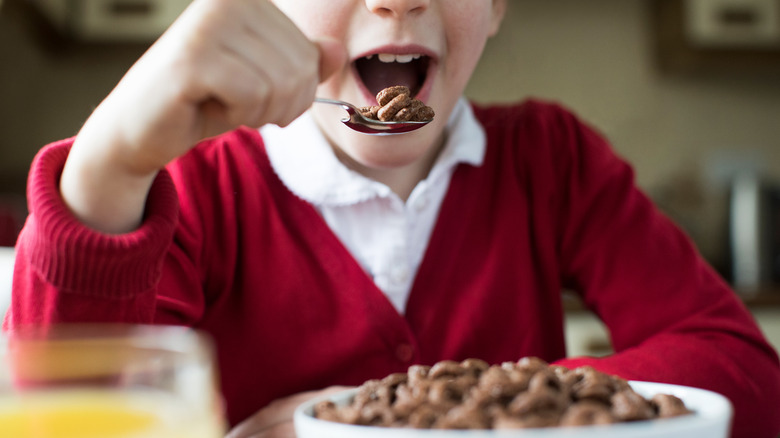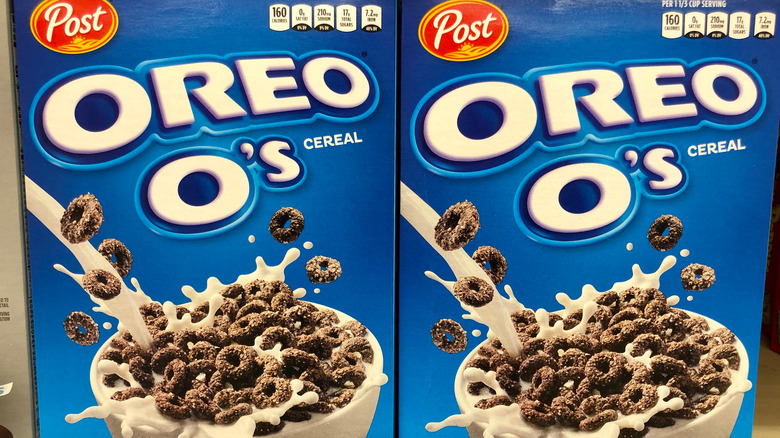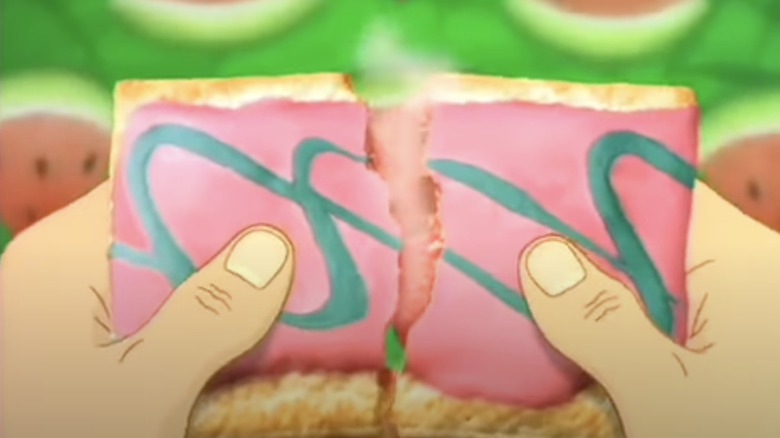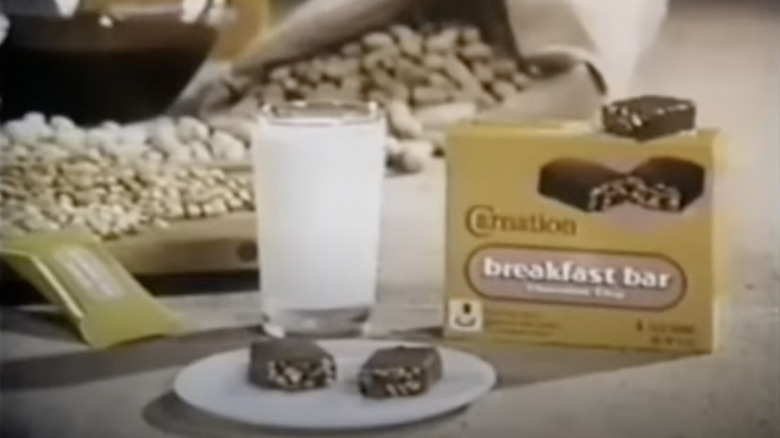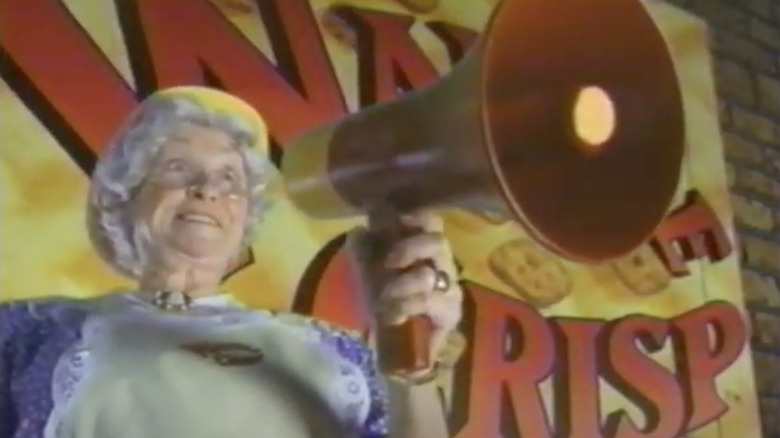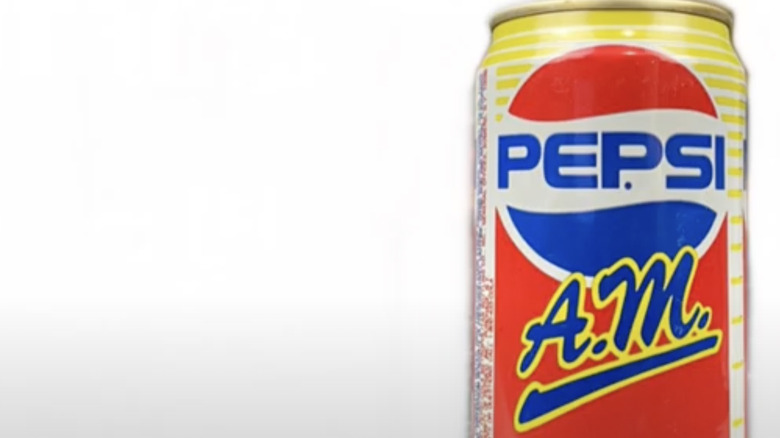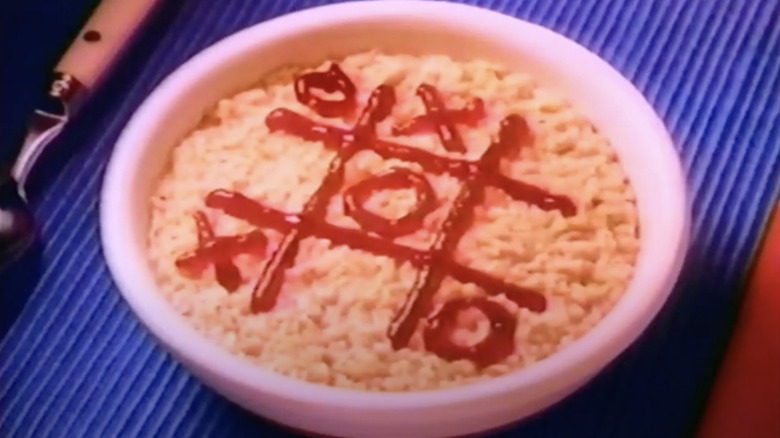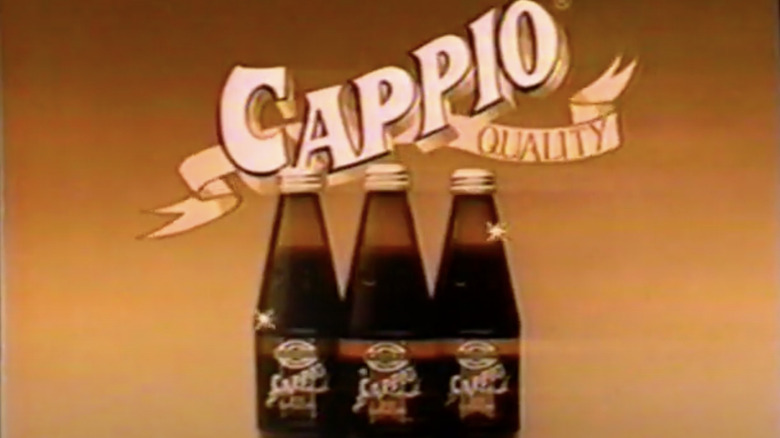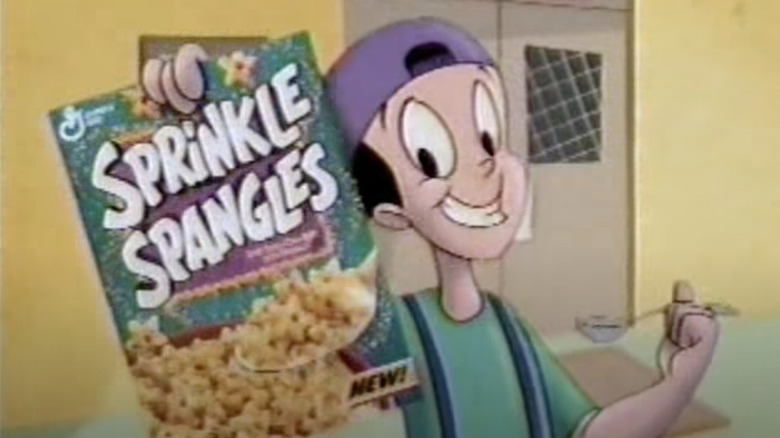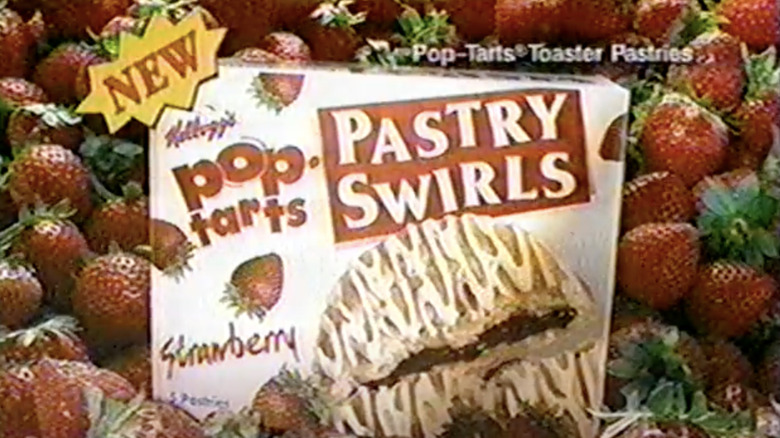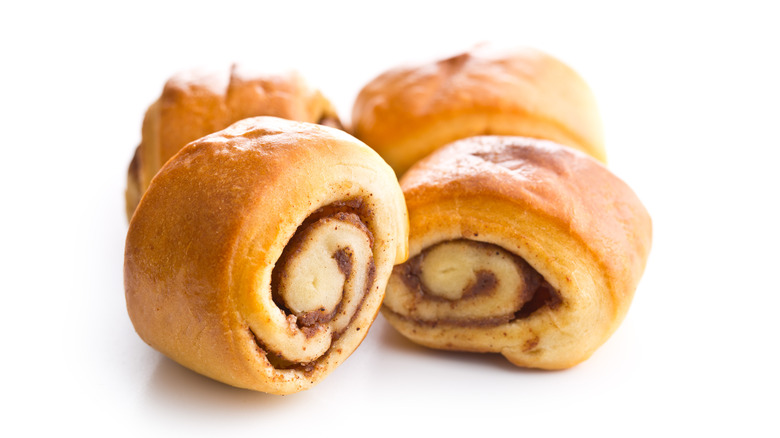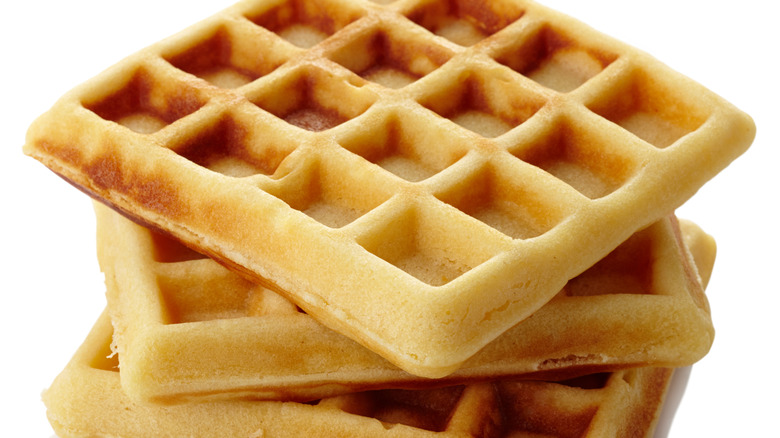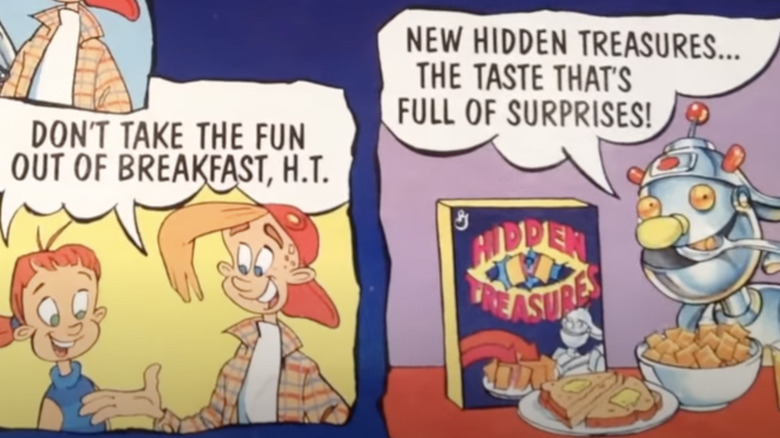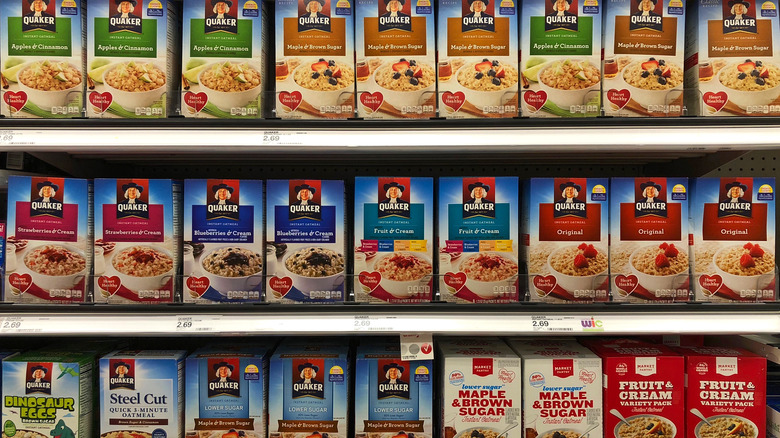13 '90s Breakfast Foods That Disappeared
Before overnight oats and avocado toast were fixtures on the morning meal scene, we had breakfast in the '90s. If you were a kid, rushed mornings before school might have involved scarfing down some untoasted Pop-Tarts from inside the school bus. There was also something ceremonial about being the first one in the kitchen on a Saturday, browsing the cereal selection, and settling in front of the TV with an overflowing bowl of sugary goodness to watch "Animaniacs". Was it the thrill-packed cartoons that had us bouncing off the walls by 9 a.m. or was it the red dye 40? More importantly, where did some of our former favorite breakfast items go?
The line between breakfast and sweet treats has always been a little blurred, but in the '90s it was downright fuzzy. It was a time when combining oatmeal and candy was (almost) as normal as pairing bacon with eggs and downing a can of soda in the morning was a hot new marketing strategy. The 1990s also saw American heritage brands struggle to compete with the rapidly evolving landscape of novelty breakfast options. Curious about the fates of some of your cherished back-in-the-day breakfasts? Here's a look at some of the '90s breakfast foods that, sadly, are now just a distant memory.
1. Oreo O's: beloved breakfast treat turned cult classic
"Milk's favorite cookie" was literally drowning in the stuff when Post's Oreo O's cereal hit stores in 1998. Post kept things fresh by giving the O's flavor upgrades over time. In 2001 Oreo's signature cream filling was coated onto the O's to make them taste even more like the cookies. A year later, "Extreme Creme" Oreo O's introduced marshmallows — and people were all about it.
This is why Oreo O's sudden discontinuance in 2007 was a shocking disappointment to its legions of devotees. Sadly, Oreo O's got lost in the fold when Post and Kraft parted ways that year. Fans the world over regarded Oreo O's as a fond and distant memory — well, except for one part of the world that never stopped selling it: South Korea.
Dongsuh Foods held distribution rights to Post cereals so they could be produced and sold in South Korea. It just so happened that Dongsuh Foods was partly owned by General Foods Corporation which was acquired by none other than Kraft. Since Dongsuh Foods was so well connected, they kept the Oreo O's train running, and no box was too stale or overpriced for nostalgic Americans who love shopping on the internet.
Ten years after (sort of) disappearing, Post teamed up with Mondelēz International to revive Oreo O's. The breakfast favorite returned to cereal aisles in the summer of 2017 and is still going strong — in 2019 they even brought back those freeze-dried marshmallows.
2. Were Wild! Watermelon Pop-Tarts too weird to last?
Kellogg's had a wild notion back in 1997 when they launched Wild! Watermelon Pop-Tarts. They even added an exclamation point after "wild" to remind you how daring it was to marry watermelon and toaster pastry as one.
The flavor marriage proved to be short-lived. Wild! Watermelon Pop-Tarts were branded as a limited edition offering, but the exclusivity didn't do much to boost sales. As the '90s drew to a close, so did Wild! Watermelon's ill-fit presence in Pop-Tart's rotating flavor selection. But it wasn't Kellogg's last attempt to present us with the idea that heated watermelon jam paste could be appetizing.
In 2015, the neon pink and green frosting returned with the release of Frosted Watermelon Pop-Tarts. Once again, the flavor was unpopular with consumers, who noted that watermelon Pop-Tarts tasted less like breakfast food and more like sweet and sour candy. Yet Kellogg's refuses to believe that Pop-Tarts and hard candy aren't compatible and resurrected the watermelon Pop-Tart for a third time in 2017 through a limited collaboration with Jolly Rancher. Before long, Jolly Rancher Pop-Tarts also disappeared from stores.
3. Carnation Breakfast Bars may have been too retro for the '90s
These quasi-protein bars were around way before the '90s– they came out in 1975. Carnation Breakfast Bars were the solid alternative to the brand's bestselling meal replacement drink mix, Instant Breakfast. The '70s-era advertisements (and the front of the wrapper) suggested that drinking a glass of milk alongside a Carnation Breakfast Bar made it a complete meal, teeming with protein, vitamins, and minerals and supplying the human body with energy — so that's what many people did.
The bars were chocolate covered and came in flavors like chocolate chip, chocolate crunch, granola with raisins, granola cinnamon, and granola with peanut butter. By the 1990s however, Carnation Breakfast Bars' sales were declining. A 1994 rebranding by Nestlé (which acquired Carnation in 1984) played up the 19 vitamins and minerals contained in every bar, sold a non-chocolate-covered version, and even included an informational phone line at the bottom of the ads that skeptics could call to make statements or ask questions.
The efforts weren't enough. Carnation Breakfast Bars vanished in 1997. In the mid-2010s Nestlé sold a similar product, the Carnation Breakfast Essentials Nutrition Bar — but it failed to fill the void left by the original Carnation Breakfast Bar and was eventually discontinued.
4. Waffle Crisp wasn't actually made by a team of grandmothers
The '90s trended hard toward brightly colored, sugary cereals, many of which were mascot driven. Waffle Crisp by Post brought the sweetness factor, but they riffed off of actual breakfast food and perceived family traditions involving grandmothers with homemade waffle recipes.
Waffle Crisp's simplicity worked. First sold in 1996, these cute, waffle-shaped morsels packed a big punch of maple. The TV commercials showed a team of devoted grandmothers baking Waffle Crisp piece by piece. By the early 2000s, the grannies' idea was replaced by a cartoon mascot named Waffle Boy who was also part of a video game made by the now-defunct Postopia Games.
Waffle Crisp had a strong run but was discontinued in 2018. Shoppers were quick to notice its absence and wanted answers. The public outcry was heard by the higher-ups at Post, which made the disappearance of Waffle Crisp short-lived. In 2022, Post re-released the popular cereal (and brought back Waffle Boy). To kick the relaunch off right, Post now offers a 20-ounce family-size box of Waffle Crisp so fans can maximize their maple-flavored nostalgia.
5. Pepsi A.M. was a pretty crazy idea
Yes, there are people who shamelessly drink soda in the morning, but Pepsi went the extra mile by trying to celebrate this questionable habit. Beginning in 1989, Pepsi began test marketing for a new derivative of its trademark cola: Pepsi A.M. — which was basically a super-charged version that contained approximately 28% more caffeine than Pepsi's standard.
In 1988 the percentage of coffee drinkers in the US was just 50%, significantly lower than the statistics of decades past. Pepsi A.M. was an attempt to infiltrate the coffee industry's stronghold on morning-time beverages. Diet Pepsi A.M., the one-calorie version of the breakfast cola was also introduced. Both sodas were sold under the tagline "The All-Night Cola", a possible nod to the night owls and soft drink enthusiasts of the younger generation.
The marketing strategy flopped. Pepsi A.M. sales were poor right out of the gate and by October of 1990, both the regular and diet versions of Pepsi A.M. disappeared for good.
6. Oatmeal Swirlers: creative or just odd?
The idea of allowing kids to unleash their creativity by drawing on instant oatmeal with a little packet of jelly seemed cute, but it also had the potential to get a little out of hand. Whether you used your bowl of General Mills' Oatmeal Swirlers as a message board to a sibling who was on your bad side that morning, or you let your breakfast get cold because you were perfecting a portrait of the family dog, this kitschy breakfast item was emblematic of the playful kid-centric food culture that was alive and well in the '80s and '90s.
Brands like Quaker have been effective at marketing instant oats to kids, but the intrigue of General Mills' Oatmeal Swirlers didn't last. They tried to play up the sweetness factor by introducing a chocolate swirler to be sold alongside the fruity flavors, but upping the sugar content in breakfast foods was a tactic that steadily lost its appeal as the '90s continued. Food brands would go on to prove that they had plenty of novel ideas to get kids excited about oatmeal, but Swirlers would not live to see another decade.
7. Maxwell House Cappio was too ahead of the curve
A June 24, 1992 issue of Hudson Valley News announced that Maxwell House had birthed a product that was a "completely new taste experience ... for today's consumer, including traditional coffee lovers, non-coffee drinkers, and trend-setters looking for an alternative to carbonated and alcoholic beverages ... " (via Hudson Valley News). It was a bottled iced cappuccino and its name was Cappio.
Cappio had the makings of greatness. It came in regular, cinnamon, or mocha. The TV commercial featured an Audrey Hepburn-esque glamourpuss and some animated beatnik percussionists grooving on some Cappio under the slogan "the thrill is the chill". Maxwell House had dared to create a coffee drink so chic and hip it was sure to be a slam dunk in the fashionista '90s — right?
Wrong. In April 1996, The Chicago Tribune informed that "sales had faltered, diving 48 percent to a mere $11 million in supermarkets for a recent 52-week period" prompting Maxwell House to retire Cappio altogether. The Tribune also made mention of a new bottled coffee drink being released by Starbucks under the "Frappuccino" moniker. We have to wonder if Cappio's fate might have shifted had it held out just a little bit longer.
8. Sprinkle Spangles cereal was pretty much miniature sugar cookies
Sure, the purple genie mascot looked like a low-budget version of the one in Disney's "Aladdin" but he definitely worked his magic with Sprinkle Spangles cereal, with a little help from the tagline "You wish it, I dish it." Released by General Mills in the early 1990s, Sprinkle Spangles was a delectable star cluster of sweet corn cereal punctured by a smattering of hyper-pigmented spherical sprinkles typically found on sugar cookies. The eyes of '90s kids were known to light up at the sight of a food-coloring rainbow, but as the decade chugged on, health studies began to suggest that its presence in kids' breakfast cereals and other foods was contributing to the rising number of attention-deficit/hyperactivity disorder (ADHD) diagnoses in youth.
It wasn't scientific reports that hurt Sprinkle Spangles' sales though, it was the fact that a lot of kids actually found the cereal to be too sweet, with one parent saying "Even my 6-year-old who loves sprinkles on everything, could hardly gag this one down." (via Deseret News). It was sentiments like this that saw Sprinkle Spangles get discontinued before the 1990s were through.
9. Pop-Tarts Pastry Swirls, the elevated toaster tart
Kellogg's insatiable desire to insert Pop-Tarts into numerous facets of breakfast culture was hardly subtle (see Pop-Tarts Crunch cereal from 1994), but the packaged food giant clearly felt the need to go toe-to-toe with the almighty Pillsbury Toaster Strudel in the mid-'90s. Enter Pop-Tarts Pastry Swirls: the pre-packaged morning-time pastry for the more discerning palette.
The Pillsbury Toaster Strudel was essentially a classed-up version of Pop-Tarts, but was the Pop-Tarts Pastry Swirl a high-end version of the Toaster Strudel? First off, they were plumper, circular, and came in old-world flavors like "cheese & cherry" that harkened back to its Danish pastry roots. Pop-Tarts Pastry Swirls were also less high-maintenance than the competition. Toaster Strudels come frozen so they have to be toasted, and once they've heated up you drizzle the icing on yourself (which they marketed as being part of the fun!). Pop-Tarts Pastry Swirls stuck to what had been working for them since the 1960s — a grab-and-go, pre-frosted breakfast goodie that can be eaten warm or cold.
So what went wrong with Pop-Tarts Pastry Swirls? Nothing really, they just weren't as popular as regular Pop-Tarts so Kellogg's phased them out. By 2001, Pastry Swirls was another part of Pop-Tarts' colorful past.
10. Burger King Cini Minis, a breakfast pastry worth protesting for
Burger King has been doing breakfast since the early 1980s but Cini Minis — an adorable four-pack of tiny Pillsbury cinnamon buns with icing served on the side didn't enter the menu until 1998. Cini Minis were tasty and portable, which gave them clout on the morning rush hour drive-thru scene. By the time the mid-2000s were upon us, Cini Minis disappeared without explanation. The public felt slighted, and they made their grievance known.
Like other breakfast foods on this list, a petition for Burger King to revive Cini Minis was launched on change.org where impassioned fans sounded off with such sentiments as "Cini Minis were a large part of my childhood until Burger King chicken-stripped them away from me ..." and "F*** BK for getting rid of these slices of heaven" (via change.org). Burger King heard the people's cries and did bring Cini Minis back in 2018 — but for a limited time only. The delectable little goo-balls exited the menu for a second time, and although Burger King has sold regular-sized cinnamon rolls on and off in the recent past, do not bring this up to Cini Mini diehards because according to change.org, they hate them.
11. The death of Downyflake Waffles
Mid-century America was embracing frozen waffles as a welcome alternative to cold cereal for days when a homemade hot breakfast was not on the agenda. Eggo debuted in 1953, but they had company in the form of Downyflake, a frozen waffle of the same era that was square and came in a plastic bag rather than a cardboard box.
Downyflake had long been used to playing second fiddle to Eggo, but they had staying power — until the '90s that is. The Downyflake name was purchased by Pillsbury in 1995, but the baking outfit made the executive decision to nix the brand entirely and sell Downyflake waffles as part of its Hungry Jack line. For the remainder of the '90s, Hungry Jack adopted Downyflake's signature square shape and insistence that its waffles were more filling and a better value than those puny, round Eggos. Eventually, even Hungry Jack would buy into the belief that frozen waffles are best served as circles and all memory of Downyflake's former cultural impact on the world of waffles was lost.
12. Hidden Treasures cereal was kind of stressful to eat
There seemed to be no limit to General Mills' funky cereal ideas in the '90s, and Hidden Treasures is a great example. As its name gives away, these unassuming corn squares came with the fun reveal of an artificially flavored fruit center — well, some of them did. The concept is clever and all, but put a bowl of Hidden Treasures in front of a neurotic child and the fun may escalate into a fixation. The temptation to eat each square individually might become too much, as could the impulse to bite open each and every square and size up their insides. Carefree consumers likely enjoyed diving into a bowl of Hidden Treasures, but for those who literally counted their fruit-filled squares and contemplated their gain, breakfast became way too existential.
For every '90s kid who was scolded by their parents for holding a piece of Hidden Treasures cereal as they bit it in half or worse — bit it and spit it back out to examine the contents –- we see you. And we dare say there must have been many of us because after debuting in 1993, General Mills pulled the plug on Hidden Treasures in 1995.
13. Quaker Sea Adventures: you know it's the '90s when there's candy in your blue oatmeal
The '90s were all about gimmicks, especially when it came to goodies for the kids. And what better way to kick off a weekend of playing "Gooey Louie" and having Nerf gun battles in the yard than with a bowl of cerulean-tinted oatmeal filled with marine-themed candy? Enter Quaker Sea Adventures instant oatmeal.
Quaker Oats is a centuries-old American food brand, and a common thread throughout its unboring history is the challenge of getting kids to crave oatmeal, because well, kids usually don't do that. The folks at Quaker were intuitive enough to know that two things kids do love are adventure and candy, which inspired the launch of Dinosaur Eggs instant oatmeal in the late 1990s. Each oatmeal packet contained "dinosaur eggs" that would hatch after you poured water on the oats and microwaved them, producing tiny Sweet-Tart-like dinos. Parents were on board, so Quaker introduced the Sea Adventures version, which took the dinosaur eggs concept underwater by incorporating artificial coloring that turned the oats blue so that the candy sharks and divers looked like they were swimming in the depths of ... bright blue oats.
By the 2000s, buzzwords like "low-carb" and "reduced-sugar" were picking up steam in advertising, and super-sweet breakfast foods felt the effects of the trend. Quaker's Dinosaur Eggs was quirky enough to endure the ups and downs of instant oatmeal's evolution and is still sold today, whereas Sea Adventures floundered into the expansive abyss of discontinued '90s breakfast foods.
